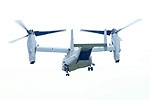Need to know, 2015: Major changes in aviation
 One of the biggest changes in Marine Corps aviation in years will happen in 2015, and it promises to not only change the way that anyone in a flight suit operates, but how anyone with boots on the ground receives support from the air.
One of the biggest changes in Marine Corps aviation in years will happen in 2015, and it promises to not only change the way that anyone in a flight suit operates, but how anyone with boots on the ground receives support from the air.
Marine Operational Test and Evaluation Squadron 22 will relocate from Marine Corps Air Station, Jacksonville, North Carolina, to Marine Corps Air Station Yuma, Arizona. The unit is taking on a more important role in the Corps and will work alongside Marine Aviation Weapons and Tactics Squadron 1. Top brass hopes the move leads to better tactics and command-and-control protocols that make the Corps a better fighter from the air.
It's one of the most significant changes in Marine Aviation in 30 years, Lt. Gen. Jon Davis, the deputy commandant for aviation, wrote in his 10-year plan for Marine Aviation.
"Co-locating VMX-22 with MAWTS-1 will allow greater synergy between our advanced weapons and tactics instructor schoolhouse and our operational test squadron — ensuring our ability to maximize the combat advantage of our new weapon systems as we field them," Davis wrote.
With the exception of the KC-130 Hercules, VMX-22 will eventually have every type of manned and unmanned aircraft found in a Marine Corps hanger. Putting these aircraft into a single squadron means the Corps will be better equipped to refine the way it flies and fights, officials said.
"It will allow VMX-22, as an (air combat element), to develop tactics, equipment and capabilities. All of these elements will be integrated, instead of each platform going off in their own separate directions. This will allow for us to better support the Marines on the ground," Marine Corps Headquarters said in a statement.
The end goal, Davis wrote, is to help aviators and ground forces in a new era where they're fighting an enemy with advanced aircraft and defenses.
"With alleged Russian separatists shooting down airliners with advanced (surface-to-air missile) systems and Hezbollah striking Israeli ships with shore-based cruise missiles, we need to be ready for not only another OEF or OIF but for a high-end threat scenario. Our future operations will be integrated with (ground combat element) operations in a contested urban environment fighting against either a nation state or non-nation state actor in an anti-access scenario," Davis wrote.
Also next year, the F-35B Lightning II will reach a major milestone in early July. If things go as planned, the aircraft will enter initial operational capability and be ready to deploy.
To reach this accomplishment, the squadron must have 10 aircraft with pilots and maintainers capable of running the unit independently. Aviators must be qualified to use the new plane for close-air support, limited offensive and defensive counter-air missions, air interdiction sorties, and other air combat capabilities.